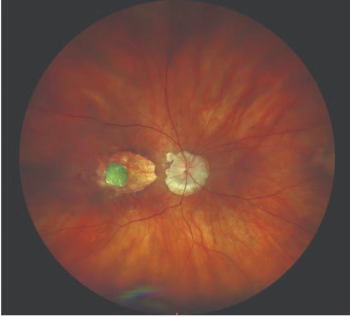
Choriocapillaris, atrophy linked with neovascular AMD
At Angiogenesis, Dr. SriniVas R. Sadda discusses how choriocapillaris may predict the rate of progression of atrophy.
On February 11, 2022, Dr. SriniVas R. Sadda presented a talk, “Choriocapillaris and Atrophy Associated with Neovascular AMD,” at the Angiogenesis, Exudation and Degeneration meeting, hosted by Bascom Palmer.
Dr. Sadda is a professor of ophthalmology at the Doheny Eye Institute at UCLA.
Video transcript
Sheryl Stevenson: Dr. Sadda, thank you so much for joining us. At this year's Angiogenesis meeting, you will be giving a presentation regarding choriocapillaris and atrophy associated with neovascular AMD. Could you give us a little bit more highlights of your talk?
Dr. Sadda: I spoke on the relationship between the choriocapillaris and atrophy associated with wet AMD. And one of the great things in the last few years is that OCT angiography has allowed us to actually study the choriocapillaris. And we've learned a lot about the relationship between the choriocapillaris and a number of different diseases.
And my area of interest in particular has been in the topic of choriocapillaris and AMD. And we've learned, for example, that the choriocapillaris worsens as the AMD disease progress goes along. And in fact, the status of the choriocapillaris may actually predict the rate of progression of atrophy in the life.
We also observe that, for example, in patients with wet AMD, the choriocapillaris tends to be poor in the areas that develop neovascularization. And maybe neovascularization is developing as a compensatory response to that poorer choriocapillaris. Whereas in eyes with atrophy, the choriocapillaris is diffusely abnormal throughout the macula. And maybe that's why those eyes go on to develop atrophy, because they don't have even a good enough choriocapillaris to develop neovascularization.
One of the things that we've also observed is that patients who have type one neovascularization—or neovascularization below the RPE—that such patients seem to be protected against the development of atrophy. In fact, sometimes we think about this as maybe being some type of a cure for atrophy.
And we wondered whether or not the choriocapillaris—or whether or not the development of a circulation like the choriocapillaris—may be a reason why these neovascular lesions may actually be protecting against the development of atrophy.
So most recently, we've studied the small vessel circulation that develops at the surface of these neovascular lesions, these type one lesions in particular. And what we observed was that lesions that seem to be less associated with atrophy, they tend to develop a better or more extensive small vessel circulation. Sometimes we call that the neo-choriocapillaris—whether that's the right term or not remains to be determined.
But the point is that this small vessel circulation that these membranes may be developing may be an important reason or mechanism as to why they can actually rescue the retina against atrophy.
And so if that's the case, and again, these are small studies still, and we'd like to see them replicated by other investigators as well. But if that proves to be correct, then it might be that in our future, our goal—with regards to treatments of wet AMD—may have to also consider what are we doing to the choriocapillaris, or this new small vessel circulation arising on the surface of these neovascular lesions in order to get the best long-term outcomes for our patients.
Sheryl Stevenson: And what might be a next step in this research?
Dr. Sadda: So really, the next step is replicating our findings. I'm a big believer that to really be confident in a result, you want that to be replicated by different cohorts, different studies, but also by different investigator teams. So I think that's important. I'd love to see that.
And I think the next important step for us personally in my lab is really thinking about, well, what happens to this in context of different treatments? Because I sort of suggested that this may have some implications for us and how we treat patients, and if that's the case, we need to understand the impact of, for example, different treatment strategies on the development of this neo-choriocapillaris circulation.
Note: This transcript has been lightly edited for clarity.
Newsletter
Keep your retina practice on the forefront—subscribe for expert analysis and emerging trends in retinal disease management.












































